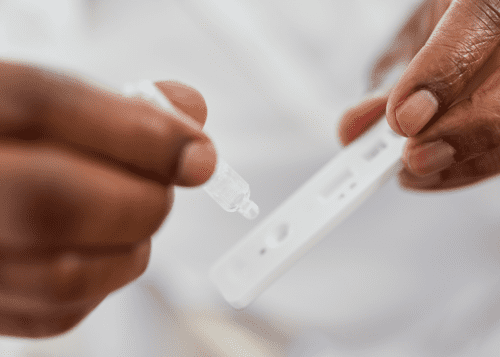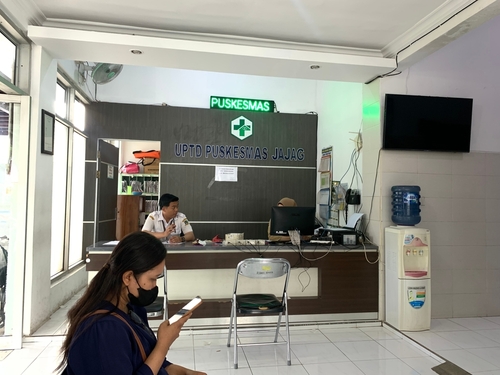September 06, 2022

Cross-sectional survey indicates that Kenyans would use COVID-19 self-testing kits if available.
One Health Trust researchers and collaborators conducted a household-based survey of 419 participants in two Kenyan counties, rural Taita-Taveta and urban Mombasa, to determine the communities’ attitude towards COVID-19 self-testing kits. Forty percent of all participants were likely to use self-tests if available, and 41.5% were very likely to do so. Approximately two-thirds were willing to pay if they could afford them. Almost all participants (93.08%) would report a positive self-test, and 95.23% would self-isolate following a positive result. Given the overall acceptance of self-tests among rural and urban Kenyan communities, this service should be developed and expanded to provide an accessible testing option to the population. [IJPH]
The absence of sustained pneumococcal conjugate vaccine (PCV)-induced antibody production puts children in Malawi at risk.
In 2011, Malawi introduced a 3+0 PCV schedule entailing one dose given at 6, 10, and 14 weeks of age. While over 90% of children followed this vaccination schedule, vaccine-serotype invasive pneumococcal disease (IPD) persisted in both PCV-vaccinated and unvaccinated individuals, suggesting vulnerability to IPD despite vaccination for PCV at a young age. Researchers evaluated 638 plasma samples from children under five in Malawi and found that vaccine-induced IgG levels against many vaccine serotypes were not sustained at the population level beyond the first year of life. The findings warrant changes to the 3+0 schedule, possibly by including a booster dose, which has been shown to decrease pneumococcal carriage and disease. [The Lancet Infectious Diseases]
COVID-19 disruptions to global TB care highlight the importance of social protection programs.
An estimated 4.3 million people fell ill with TB, and 700,000 died in 2020. The WHO South-East Asia (SEA) Region carries the highest TB burden; however, in the year 2020, the region saw a 20-40% decline in TB case detection. Economic disruption caused by the pandemic has worsened poverty and undernutrition, increasing vulnerability to TB infection but delaying and even preventing TB diagnosis and treatment. The global incidence of TB could be reduced by as much as 75% if poverty were eliminated and social protection programs were implemented. [PLOS Global Public Health]
New evidence suggests that SARS-CoV-2 originated in wildlife trading in a Wuhan, China market.
Multiple zoonotic transmission events at the Huanan Seafood Wholesale Market in Wuhan, China occurring within a one- or two-month period, likely resulted in the emergence of the two viral lineages of SARS-CoV-2 identified early in the pandemic. Genomic and epidemiological data have been used to show that Huanan Market stalls that sold SARS-CoV-2-susceptible animals correlate spatially with SARS-CoV-2- positive environmental samples. [Science]
Declines in vaccination coverage among children globally, especially in low-and middle-income countries (LMICs).
In 2020, 57 lower-income countries saw a four percent drop in children’s diphtheria-tetanus-pertussis (DTP3) vaccination, reducing vaccine coverage to 78%. This drop corresponds to a vastly increased risk of children contracting preventable infectious diseases. The global fall in vaccination coverage is primarily driven by larger countries such as the Democratic Republic of the Congo and India. Despite the alarming decrease in vaccinations, many LMICs recovered quickly and restored pre-pandemic vaccination levels. However, long-term commitment from supporting organizations is needed to ensure widespread vaccine distribution in LMICs. [Scientific American]
High rates of AMR in very preterm infants with early onset sepsis (EOS).
Researchers profiled organisms and antimicrobial resistance of pathogens causing EOS in infants in a prospective, observational cohort study involving 32 newborn intensive care units (ICUs) and 108 cases of EOS in very preterm infants (born at less than 32 weeks of gestation) in China between January 2018 to December 2020. The study found that very preterm infants were at much greater risk for EOS than more mature infants, with the incidence of EOS highest in infants with a gestational age of 23–28 weeks (35.8%) and lowest among those with a gestational age of 31–32 weeks (13.5%). Escherichia coli (n=44, 40.7%) and Klebsiella (n=10, 9.3%) spp. were the predominant organisms, and both showed high resistance rates to ampicillin and third-generation cephalosporins. [Infectious Diseases and Therapy]
Resistances to fluconazole and coinfections among vaginal discharge syndrome (VDS) patients could impact treatment efficacy.
In a cross-sectional study investigating the prevalence of Candida infection, antifungal resistance, and coinfections in Namibian women with VDS, researchers collected 253 vaginal swabs from women aged 18-49 years between February to July 2021. Among participants infected with Candida (43%), 36% were infected with Candida albicans, and 9.5% had non-albicans Candida species. Candida albicans were more frequently isolated in younger (p=0.004) and pregnant women (p=0.04) and almost all (98%) were susceptible to fluconazole, while all non-albicans Candida species were fluconazole-resistant. [Antimicrobial Resistance and Infection Control]
Investment and infrastructure are needed to improve Africa’s capacity to diagnose and contain future monkeypox outbreaks.
Although confirmation of monkeypox infection is done using conventional PCR to detect viral DNA samples from rashes, only seven countries in Africa can currently sequence the monkeypox virus. In addition, a shortage of trained healthcare workers and inadequate power supply, and infection prevention and control techniques are among the challenges that limit rural and low-income areas of Africa from properly diagnosing and treating the disease. [International Journal of Infectious Diseases]
High rates of AMR in Escherichia coli in urban Ghana
. In a one-year retrospective study conducted in a private diagnostic center in the Cape Coast Metropolis of Ghana from January to December 2019, researchers investigated antimicrobial susceptibility patterns and distributions by patient demographics in 331 specimens sampled from urine, stool, blood, cervical, and wound samples. Approximately 38% were positive for microbes, with most isolates being gram-negative. The greatest number of pathogens were found in high vaginal swabs (44%) and urine (40%) samples. A significant number of pathogens were resistant to more than one type of antibiotic (p <0.05), with Escherichia coli showing the highest level of resistance. [Scientific Reports]
HIV services must adapt in the face of interruptions like the COVID-19 pandemic to ensure ongoing care.
Researchers conducted 14 key informant interviews (ten with regular health workers and four with workers specializing in anti-retroviral therapy) related to anti-retroviral therapy at six large primary health care facilities in Kampala, Uganda, to address how health facilities might ensure the delivery of HIV services amidst interruptions like those experienced during the COVID-19 pandemic. Four main themes emerged regarding continuity of HIV services in the post-COVID-19 period, including leveraging mobile phone technology to support patient care, adoption of novel delivery methods (motorcyclists), scale-up of existing delivery methods (such as a fast-track refill service or a community-led pharmacy), and reorientation of health facility functioning (including more flexible transportation and surveillance services). [PLOS Global Public Health]











